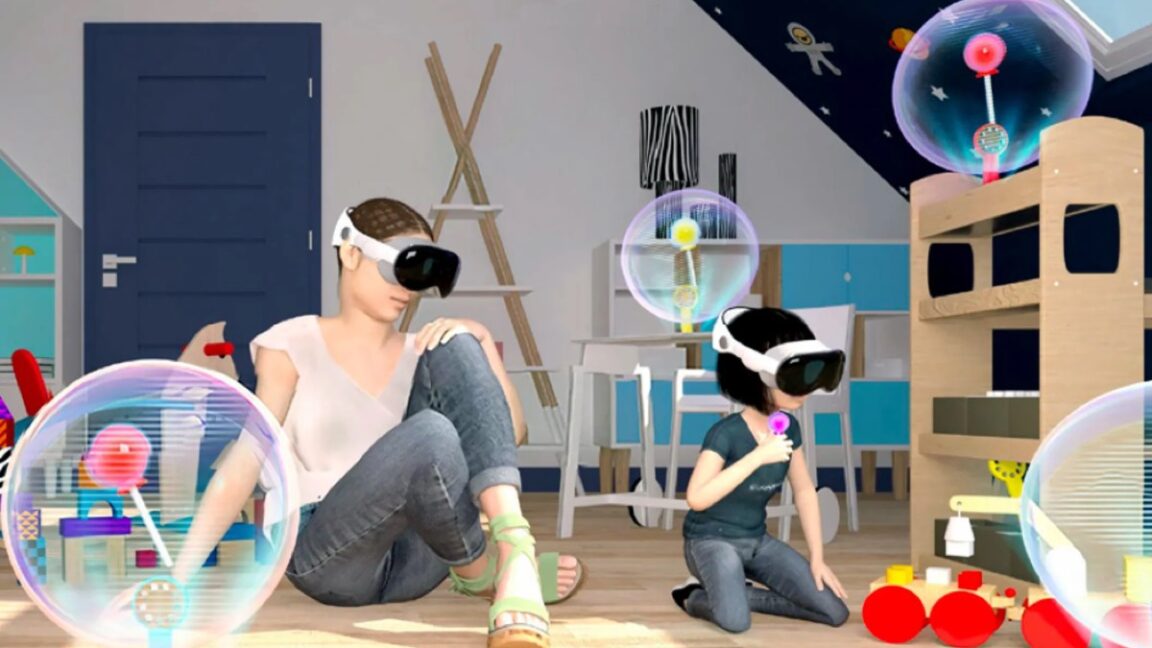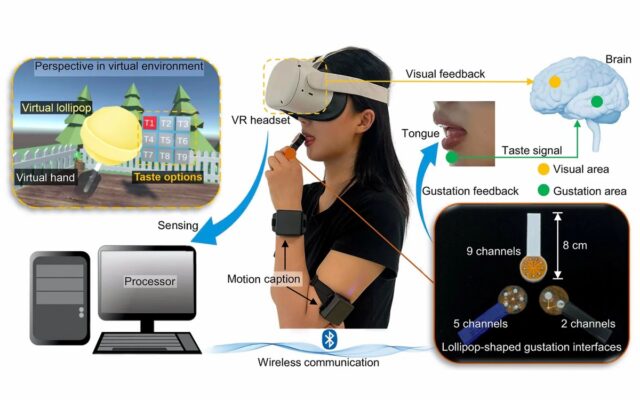It produces nine flavors: Sugar, salt, citric acid, cherry, passion fruit, green tea, milk, durian, and grapefruit.

A new interface to simulate taste in virtual and other extended reality (XR) environments. Credit: Liu et al., 2024/PNAS
Virtual reality (VR) technology has long sought to incorporate the human senses into virtual and mixed-reality environments. In addition to sight and sound, researchers have been trying to add the sensation of human touch and smell via various user interfaces, as well as taste. But the latter has proved to be quite challenging. A team of Hong Kong scientists has now developed a handheld user interface shaped like a lollipop capable of re-creating several different flavors in a virtual environment, according to a new paper published in the Proceedings of the National Academy of Sciences (PNAS).
It’s well established that human taste consists of sweet, salty, sour, bitter, and umami—five basic flavors induced by chemical stimulation of the tongue and, to a lesser extent, in parts of the pharynx, larynx, and epiglottis. Recreating those sensations in VR has resulted in a handful of attempts at a flavor user interface, relying on such mechanisms as chemical, thermal, and electrical stimulation, as well as iontophoresis.
The chemical approach usually involves applying flavoring chemicals directly onto the tongue, but this requires room for bulk storage of said chemicals, and there is a long delay time that is not ideal for VR applications. Thermal variations applied directly to the tongue can stimulate taste sensations but require a complicated system incorporating a cooling subsystem and temperature sensors, among other components.
The most mainstream method is electrical stimulation, in which the five basic flavors are simulated by varying the frequency, intensity, and direction of electrical signals on the tongue. But this method requires placing electrode patches on or near the tongue, which is awkward, and the method is prone to taste biases.
Ars Video
How The Callisto Protocol’s Gameplay Was Perfected Months Before Release
So Yiming Liu of City University of Hong Kong and co-authors opted to work with iontophoresis, in which stable taste feedback is achieved by using ions flowing through biologically safe hydrogels to transport flavor chemicals. This method is safe, requires low power consumption, allows for precise taste feedback, and offers a more natural human-machine interface. Liu et al. improved on recent advances in this area by developing their portable lollipop-shaped user interface device, which also improves flavor quality and consistency.
A matter of taste

Key to the miniaturization was the use of an optimized layout of components on two layers of ultra-thin printed circuit board housed in a lightweight, 3D-printed Nylon lollipop-shaped casing. There were nine taste-generating channels filled with flavored hydrogels. The gels were made out of agarose mixed with a bit of mineral water and specific flavor essences: sugar, salt, citric acid, cherry, milk, green tea, passion fruit, durian, and grapefruit.
System components included a lithium-ion battery, a microcontroller, Bluetooth module, resistors, capacitors, N-type and P-type MOSFETs, and linear regulators for wirelessly controlling the flavor channels via a graphical user interface (GUI) in the virtual environment. The final device measured 8×3×1 cm and weighed about 15 grams, on par with your average Tootsie Pop.
Flavors are generated via a current flowing through a target gel, delivering flavor chemicals to the outside of the lollipop. Users can then lick the device to experience the flavors. Adding smell to the mix—seven specific odor chemicals—further enhances the perception of taste. Future research will focus on extending the time range for the device, currently limited to about an hour because the chemically infused hydrogels shrink and run out of flavor.
Liu et al. described three potential applications for their lollipop device in their paper. The first is in virtual standardized taste tests akin to hearing or vision tests. Many people suffer from “gustatory disorders,” per the authors, but the current tests for such conditions are highly subjective and are time-consuming to prepare, since it requires a series of solutions of varying concentrations for all five basic flavors. The lollipop device could be adapted for such a test, in which users could lick the device and provide feedback about what they taste by clicking on the relevant button on a corresponding GUI.
Another potential use is immersive online shopping in virtual grocery stores. Users could touch a specific virtual food and be able to taste that item. The device could also prove useful in a mixed-reality educational environment, such as a parent helping their child explore the flavors of different foods.
PNAS, 2024. DOI: 10.1073/pnas.2412116121 (About DOIs).




